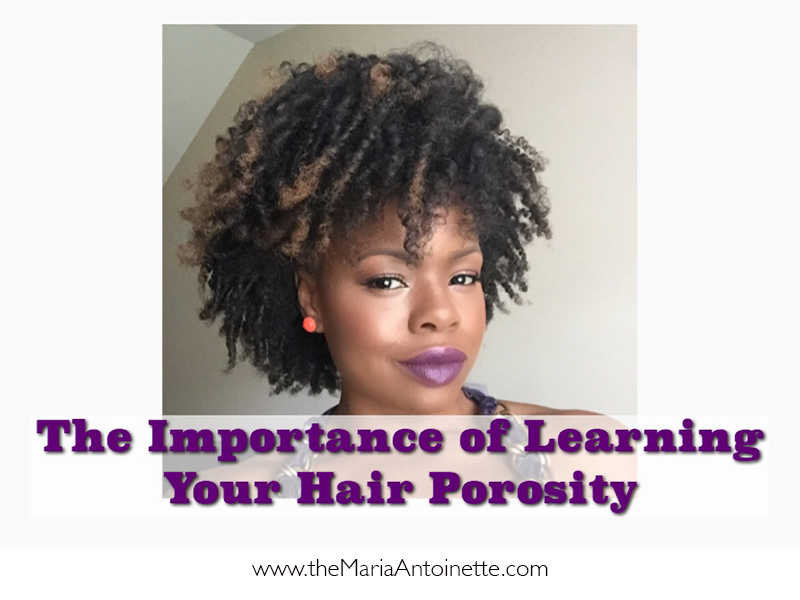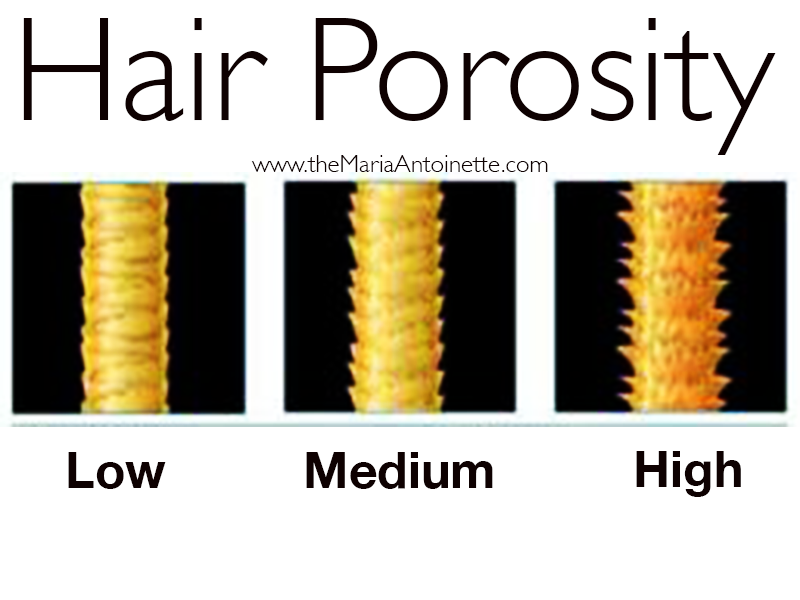I recently spoke at the International Natural Hair Meet-up Day here in Knoxville, TN and I am now co-hosting a 30 Day Grow Your Fro Protective Style Challenge. The common denominator in talking with both groups of women all lead back to moisture. I had to sit and think about the things that have really helped me in my natural hair journey. Yes, products and techniques…but these things are built on knowing your hair. When I say knowing your hair I am not referring to just your hair type but knowing your actual hair (the strands and their unique way of working). In cosmetology school I learned all about porosity and had been using that knowledge for so long it is like second nature. But when I really started to listen to the complaints in the natural hair community it hit me…many women do not know their hair porosity. In this post I will go over the importance of learning your hair porosity, how to treat the three different levels of hair porosity and the best products to use for each level.
What is Porosity: Porosity is the hair’s ability to absorb and retain moisture.
*Image from Google
Types of Porosity
- Low porosity – the cuticle (outer layer of your hair) lays flat and tight, making it difficult for moisture to enter the cuticle to reach the core and keep the hair moisturized
- Medium porosity – the cuticle is slightly raised which allows moisture to enter the cuticle and remains in the core without escaping
- High porosity – the cuticle is extremely raised making it easy for moisture to enter but just as easy for moisture to leave, so it’s difficult to retain moisture
How to Test for Porosity:
Water test – Drop a strand of clean (product free) hair into a glass of room temperature water for 1 – 2 minutes
- Low porosity – floats for more than 1 – 2 minutes before sinking
- Medium porosity – hovers in the middle of the glass for 1 – 2 minutes before sinking
- High porosity – sinks before 1 – 2 minutes
Feel test – Run your thumb and middle finger over a few strands of clean (product free) hair going roots to ends and back up
- Low porosity – smooth going down and up the shaft of hair. You will not feeling any texture
- Medium porosity – smooth going down the strand of hair but slightly rough going up the strand of hair
- High porosity – extremely rough & jagged when you run your fingers up or down the strand of hair
Best Techniques and Products for your Hair Porosity:
- Low Porosity – Biggest issue is getting moisture into the hair shaft past the cuticle
- Ways to open the hair cuticle: Must open the hair cuticle to allow the hydration/moisture in
- Protein based pre- poo treatments
- High Alkaline pre- poo treatments
- Heat during your deep conditioner: steamer, hood dryer with shower cap on, warm towel wrapped around your head with a shower cap on
- Add Glycerin to your conditioner
- Ways to close the hair cuticle: Must close the cuticle to keep the hydration/moisture in
- Rinse with cool water
- Spray or apply a cold leave-in
- Use Aloe Vera Juice (should be keep in the fridge)
- Seal with a lightweight oil or butter:
- Argan Oil
- Sweet Almond Oil
- Grape Seed Oil
- Mango Butter
- Avocado Butter
- Butter Blends (using the butters and oils listed above)
- Ways to open the hair cuticle: Must open the hair cuticle to allow the hydration/moisture in
Medium Porosity
- Medium Porosity means slightly open cuticle heat with DC’s aren’t a necessity but still effective
- Moisturize with a liquid based leave-in conditioner
- Use products that have water listed in the top 3 ingredients
- Hair milks
- Light creams
- Moisturize with a liquid based leave-in conditioner
- Seal with light to medium weight oils and butters:
- Jojoba oil
- Avocado oil
- Coconut oil
- Mango butter
- Aloe Vera butter
- A light whipped butter mixed with oils
High Porosity – Biggest issue is keeping moisture in the hair shaft
- Closing the hairs cuticle is just as important as sealing when you have high porosity
- Ways to close the hair cuticle: Must close the cuticle to keep the hydration/moisture in
- Rinse with cool water
- Spray or apply a cold leave-in
- Use Aloe Vera Juice (should be keep in the fridge)
- Ways to close the hair cuticle: Must close the cuticle to keep the hydration/moisture in
- Try low humectant or non-humectant products, especially in climates with high humidity as too much water can lead to the hair swelling and causing extra frizz
- Use butters with a high fat content as they provide a wall around the hair’s cuticle
- Shea Butter
- Cocoa butter
- A whipped Shea/Cocoa butter mixed with oils
- Seal with high fat oils:
- Sacha Inchi Oil
- Jamaican Black Castor Oil
- Castor oil
- Coconut oil
- Olive oil
Here is a video of how I make my Whipped Body Butter…this can be used on hair and skin.
Now that you have the foundation of understanding your hair the rest should get easier. When picking products for your hair focus on the ingredient. Also note that your hair porosity can change from low to medium and high to medium. Porosity often changes with chemicals such as color, even heat plays a roll in your hair’s ability to absorb and maintain moisture. I hope you all found this post on the importance of learning your hair porosity helpful. In all we do for the care of our hair, it is nice to slow down and get back to the basics.
Also check out this weeks #ProctiveStylespiration
Latest posts by Maria Antoinette (see all)
- 10 Romantic Date Night Ideas For Any Time of The Year - January 26, 2023
- Tips To Help You Reconnect With What Brings You Joy - January 19, 2023
- Planning A Road Trip? Here Are Some Key Tips You Should Know - January 12, 2023





This is the first definition of hair porosity that can totally understand. And, thank you for also giving the examples of products to use for each.
Thank you for stopping by!!! I am glad the article was helpful!
Hi, Lovely article and thanks for the tips.
I have a few questions about hair porosity. I think I have low porosity hair (strand doesnt sink, my hair takes forever to dry,)
I read some articles about handling lopo hair and tried it out. The results were awful.
please what are protein preepoos? can i do a cold water rinse? what types of deep conditioning should i stick to?
Thanks a lot
Hello,
With Lopo hair you will need to open your hair shaft try heated deep conditioners, rinse with cold water. Your Conditioners should be water based and no silicone. Yogurt pre poos are a good protein prepoo simple google protein prepoos. Hope this helps